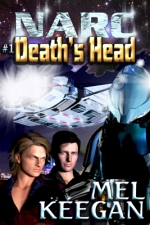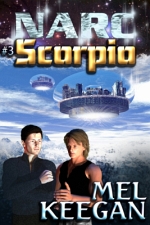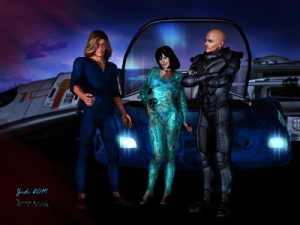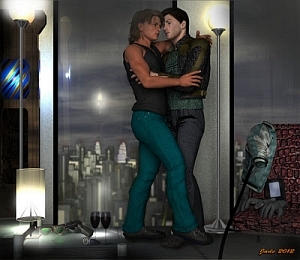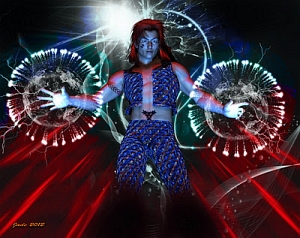above: the warrior rendered by Lux, via Reality...
below: same scene raytraced by DAZ Studio
Reality and Lux have been installed ... have been opened and used ... and ye gods, there's so much to learn! You know how it works. You start up new software, something you never used before even though it's going to do essentially the same job, and the first reaction, the kneejerk, is to panic and run around the room screaming and waving your arms. Not that this helps, you understand. But the human brain sure loves to do it -- so much so, in fact, that it would be crass of me to skip this time honored step.
So after the installation and the startup, I ran around screaming for the prerequisite 42.85 seconds. Then I hit the forums and watched a tutorial video on YouTube, and started (I stress started!!) to make sense of how it all works. This one has a long, high, steep learning curve, and it's going to be "one thing at a time, for quite some time" before I get the renders I want. But --
As a first outing, this isn't too bad, and I learned a lot. I won't bore you with the details, but at a glance in these two images, above, you can see a couple of things. Skin tones have a dimension more luminosity -- and this was what I was after! But Reality/Lux has left behind the bump map that gives the character in the raytraced version more detailed skin. On the good side of things, I did manage to stumble over a place in the interface to add displacement or bump maps ... which in Reality are called "modifiers." So, next time around I'll be adding a bump map and figuring out how to fine tune it...
That will be the third hurdle out of the way. The first was that Lux was crashing on startup, every single time I tried to open it. Uh huh. A quick check of the forums at http://preta3d.com showed that I wasn't the first person to report this, and also turned up a way to stop it happening. Know that fabulously powerful graphics card that should make your renders go twice as fast? Do not, repeat not, option it. Lux has a hernia when confronted with it. The second hurdle was that the character's eyes were rendering like flat black balls, sclera (white) and all. Fortunately, the power behind Reality, a really nice man called Paolo Ciccone (forgive me if I'm mis-spelling that), whose accent reminds me strongly of Ricardo Montolban, has a video at YouTube that got me through that swamp without too many mossie bites.
Lux is very different ... it's called an 'Infinite Render' engine -- because it never stops. You can get a halfway decent render in maybe 30 mins, with 500 samples per pixel, but if you let it run, an hour later you have 1,000 samples per pixel, and so forth. The more samples per pixel, the higher the resolution. You decide when enough is enough, and stop the render. So cool.
So the Lux render, top picture above, is at 1,500 samples per pixel. It's a quite small image, just 653 x 832 pixels. The object is to keep the images small(ish) while I'm learning this stuff, because at this size, on a powerful computer, you're still looking at 2 hours 20mins to get to that resolution. A picture twice the size, in linear terms, will take four times as long -- you know the old thing, linear versus area size? Same deal.
Anyway, the lustre is there on the skin ... and I did lean how to make eyes render as "not dead black." But -- full disclosure here! -- the top image is a cheat. In Reality, I adjusted the eyeballs, and also put a new texture and gloss value on the blades of the crossed spears in the background ... but I decided to just render the thing right there and see how it came out, and use this as a "reference picture," as per time, lighting, textures, shadows, and what have you. Welllllll ... I need to work out how to make hair render properly! Because the Yannis Rastra dreads on this guy are cheated, and the eyeballs are (!) copied over from the rayraced image, because, although they rendered like eyes, they were "lifeless," without any gloss or sparkle or shine.
So, next lessons, for me: get the hair and eyes right, and get the bump mapping ("Modifiers") to come back in ... and then set a Lux render to go all night, and see what it looks like by the time it's up to maybe 5,000 samples per pixel, which would be around brekkie time!
There's a 115pp PDF user guide, and I need to learn, all over again, how to handle lighting. A lot of it is like "unlearning" anything you thought you knew. But hey, this is how you keep your brain flexible, right? I'm very optimistic that I can learn this in a reasonable time, and we can start seeing those incredible, luminous renders I've been drooling over on the pages of people who render with Firefly. In fact, I know -- fact -- Lux will dance rings around Firefly, but only when I've learned it. Because (unlike sending an image to the Firefly engine), when you send a project to Reality, to be rendered in Lux, you generally have to work on every single material in the whole image. And there can be hundreds. Then, a large image could easily take days to render up. Fortunately, Lux has a "pause render" button, like Bryce, so you can put the work on hiatus while you use the computer for other stuff, and start it again when you go to bed on the second day, and the third, etc., and so forth. Phew!
For now, check out the details:
All this needs is more render time, to make the skin tones smoother. I'm guessing that 5 - 8 hour renders, maybe 10 hour renders, are going to become commonplace. Hmmm. I wonder if I need more RAM?
Jade, April 10



























































